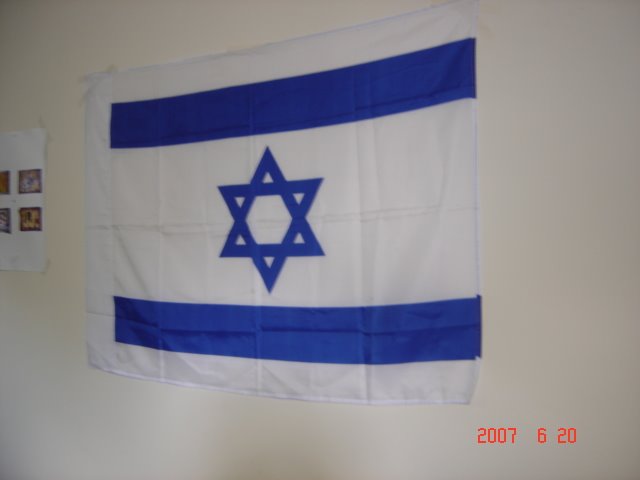Friday, June 16, 2006
Does Anyone Care About Israel's Holy Sites?
In recent years, Israelis and Jews around the world have looked on with horror as the Palestinians desecrated Jewish holy sites. From the dismantling of Joseph's tomb in Shechem (Nablus), to the wanton destruction of the synagogues in Gush Katif, our ostensible "peace partners" have shown little inclination to respect all that is holy and sacred to the Jewish people.
But the sad fact is that Israel itself has not done very much to respect and maintain our own holy sites, many of which lie in an appalling state of decay and neglect. As I note in the article below from today's Jerusalem Post, it is time for us to show our ancestors, and ourselves, a bit more respect in this regard.
The Jerusalem Post, June 7, 2006
No Way to Treat Our Founding Fathers
By Michael Freund
Everyday, thousands of people drive right past it, barely noticing the small stone structure that lies along the highway outside of Kibbutz Eyal, near Kfar Saba.
The building sits quietly amid a field, with its domed ceiling waging what appears to be a losing battle against foliage and neglect.
From year to year, the cracks in the roof grow ever larger and more ominous, and it seems that it is only a matter of time before the edifice simply collapses.
Welcome to the burial place of Shimon (Simeon), son of the Biblical patriarch Jacob.
The first time I visited the site, I could not believe my eyes. The tomb itself is a two-layered block of stone in the middle of the one-room structure, and it is surrounded by a dirt floor and filthy, unpainted walls.
The decay is dreadful, the dilapidation downright depressing.
This, after all, is the burial place of one of the founding fathers of the Jewish people. It is a piece of our nation's history, and it lies in near ruin.
How could such a thing be allowed to occur?
It is akin to visiting George Washington's grave at Mount Vernon, Virginia, or Napoleon's tomb at Les Invalides in Paris, and finding them in a state of utter and complete disrepair.
Can anyone imagine the paint at Queen Victoria's mausoleum in Windsor, England, being allowed to peel off the walls? Or the ceiling at Grant's Tomb in upper Manhattan being overtaken by untended shrubbery?
Some of you are probably thinking: that's all fine and nice, but we know for sure where Washington is buried, and where Napoleon was laid to rest. But who says that crumbling structure outside Kfar Saba really is the tomb of Simeon?
Interestingly enough, the site is considered holy both by Jews and by local Arabs, who referred to it over the centuries as A-Nebi Shimaan, or "the prophet Simeon." The Samaritans also identify the tomb as such, thereby placing the burden on the skeptics to explain just how these three traditions, which so often clash, nonetheless point to this very same place as the burial ground of the Biblical figure.
Unfortunately, though, Simeon's tomb is not alone when it comes to a pronounced lack of care and attention. The burial places of some of his famous siblings are not in much better shape, too.
Neither the tomb of Benjamin, also outside Kfar Saba, nor the tomb of Judah, in the town of Yehud, can be said to be in sparkling, pristine condition. Though they are visited regularly by a stream of pilgrims and worshipers, the conditions at both sites are woefully appalling.
ALL TOLD, Israel is home to over 120 Jewish holy sites which dot the landscape, from the Cave of the Patriarchs in Hebron to the Western Wall in Jerusalem. They stand as silent witnesses, providing incontrovertible proof for our people's age-old presence in this land.
According to statistics compiled by Israel's Holy Sites Authority, which is now part of the Ministry of Tourism, over 7 million people visit the holy sites each year. This includes everyone from yeshiva students to new immigrants to Christian tourists from abroad.
Some seek out the holy places as a means of drawing closer to God, while for others it might be out of curiosity or a desire to come into contact with a piece of history.
But whatever the motivation, these sites provide visitors with a range of meaningful experiences, be they religious, social or educational in nature.
A visit to Rabbi Akiva's grave in Tiberias, or King David's Tomb on Mount Zion in Jerusalem, provides a window not only into our nation's past, but also to its soul.
And that is precisely why the government's disregard for their upkeep is so utterly shameful.
Incredibly, the annual budget for protecting, maintaining and repairing the holy places (not including the Western Wall) is a paltry NIS 4.6 million.
By contrast, Israel's 50 largest museums, which draw less than one-third the number of those who visit the holy sites, nonetheless receive five times the amount of support each year from the Treasury.
The government is literally throwing pennies at our heritage, doing virtually nothing to preserve these national and historical monuments or to make them more accessible to the public.
Take, for example, the Tomb of Habakkuk the prophet, which is located in the lower Galilee. Though it is adjacent to Route 65, the dirt path leading down to the tomb from the highway is not even paved.
And then there is the grave of the Talmudic sage Rabban Shimon ben Gamliel, in Kafr Kana, which has been repeatedly vandalized by local Arabs in recent years, because little is done to protect the site.
This is no way to be treating the founding fathers of the Jewish people, those who gave us the wisdom and heritage that we have struggled so long and so hard to keep.
The state of the holy sites in Israel today is an insult not only to them, but to ourselves, too, and it is time for the government to correct this.
After all, you can tell a lot about a country by the respect that it shows for its forefathers.
And ours, I dare say, deserve a whole lot more.
But the sad fact is that Israel itself has not done very much to respect and maintain our own holy sites, many of which lie in an appalling state of decay and neglect. As I note in the article below from today's Jerusalem Post, it is time for us to show our ancestors, and ourselves, a bit more respect in this regard.
The Jerusalem Post, June 7, 2006
No Way to Treat Our Founding Fathers
By Michael Freund
Everyday, thousands of people drive right past it, barely noticing the small stone structure that lies along the highway outside of Kibbutz Eyal, near Kfar Saba.
The building sits quietly amid a field, with its domed ceiling waging what appears to be a losing battle against foliage and neglect.
From year to year, the cracks in the roof grow ever larger and more ominous, and it seems that it is only a matter of time before the edifice simply collapses.
Welcome to the burial place of Shimon (Simeon), son of the Biblical patriarch Jacob.
The first time I visited the site, I could not believe my eyes. The tomb itself is a two-layered block of stone in the middle of the one-room structure, and it is surrounded by a dirt floor and filthy, unpainted walls.
The decay is dreadful, the dilapidation downright depressing.
This, after all, is the burial place of one of the founding fathers of the Jewish people. It is a piece of our nation's history, and it lies in near ruin.
How could such a thing be allowed to occur?
It is akin to visiting George Washington's grave at Mount Vernon, Virginia, or Napoleon's tomb at Les Invalides in Paris, and finding them in a state of utter and complete disrepair.
Can anyone imagine the paint at Queen Victoria's mausoleum in Windsor, England, being allowed to peel off the walls? Or the ceiling at Grant's Tomb in upper Manhattan being overtaken by untended shrubbery?
Some of you are probably thinking: that's all fine and nice, but we know for sure where Washington is buried, and where Napoleon was laid to rest. But who says that crumbling structure outside Kfar Saba really is the tomb of Simeon?
Interestingly enough, the site is considered holy both by Jews and by local Arabs, who referred to it over the centuries as A-Nebi Shimaan, or "the prophet Simeon." The Samaritans also identify the tomb as such, thereby placing the burden on the skeptics to explain just how these three traditions, which so often clash, nonetheless point to this very same place as the burial ground of the Biblical figure.
Unfortunately, though, Simeon's tomb is not alone when it comes to a pronounced lack of care and attention. The burial places of some of his famous siblings are not in much better shape, too.
Neither the tomb of Benjamin, also outside Kfar Saba, nor the tomb of Judah, in the town of Yehud, can be said to be in sparkling, pristine condition. Though they are visited regularly by a stream of pilgrims and worshipers, the conditions at both sites are woefully appalling.
ALL TOLD, Israel is home to over 120 Jewish holy sites which dot the landscape, from the Cave of the Patriarchs in Hebron to the Western Wall in Jerusalem. They stand as silent witnesses, providing incontrovertible proof for our people's age-old presence in this land.
According to statistics compiled by Israel's Holy Sites Authority, which is now part of the Ministry of Tourism, over 7 million people visit the holy sites each year. This includes everyone from yeshiva students to new immigrants to Christian tourists from abroad.
Some seek out the holy places as a means of drawing closer to God, while for others it might be out of curiosity or a desire to come into contact with a piece of history.
But whatever the motivation, these sites provide visitors with a range of meaningful experiences, be they religious, social or educational in nature.
A visit to Rabbi Akiva's grave in Tiberias, or King David's Tomb on Mount Zion in Jerusalem, provides a window not only into our nation's past, but also to its soul.
And that is precisely why the government's disregard for their upkeep is so utterly shameful.
Incredibly, the annual budget for protecting, maintaining and repairing the holy places (not including the Western Wall) is a paltry NIS 4.6 million.
By contrast, Israel's 50 largest museums, which draw less than one-third the number of those who visit the holy sites, nonetheless receive five times the amount of support each year from the Treasury.
The government is literally throwing pennies at our heritage, doing virtually nothing to preserve these national and historical monuments or to make them more accessible to the public.
Take, for example, the Tomb of Habakkuk the prophet, which is located in the lower Galilee. Though it is adjacent to Route 65, the dirt path leading down to the tomb from the highway is not even paved.
And then there is the grave of the Talmudic sage Rabban Shimon ben Gamliel, in Kafr Kana, which has been repeatedly vandalized by local Arabs in recent years, because little is done to protect the site.
This is no way to be treating the founding fathers of the Jewish people, those who gave us the wisdom and heritage that we have struggled so long and so hard to keep.
The state of the holy sites in Israel today is an insult not only to them, but to ourselves, too, and it is time for the government to correct this.
After all, you can tell a lot about a country by the respect that it shows for its forefathers.
And ours, I dare say, deserve a whole lot more.




